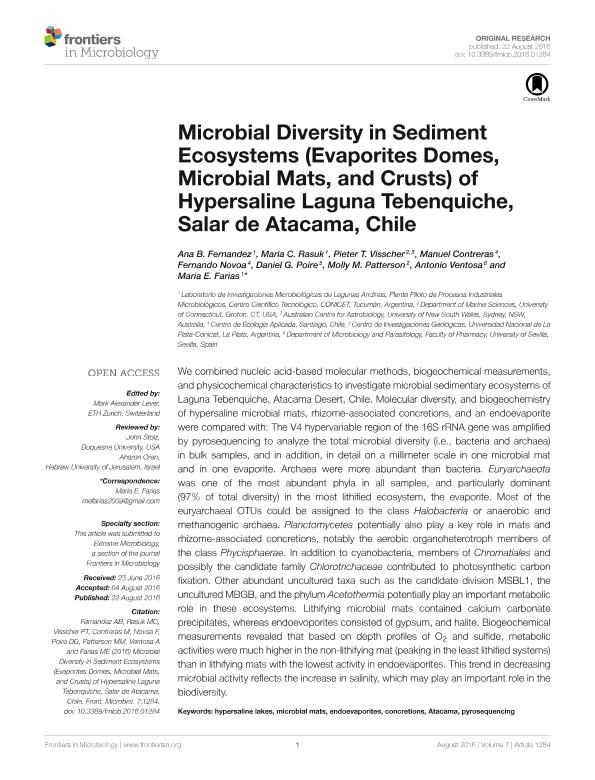Artículo
Microbial diversity in sediment ecosystems (evaporites domes, microbial mats, and crusts) of Hypersaline Laguna Tebenquiche, Salar de Atacama, Chile
Fernandez Gonzalez, Ana Beatriz ; Rasuk, Maria Cecilia
; Rasuk, Maria Cecilia ; Visscher, Pieter T.; Contreras, Manuel; Novoa, Fernando; Poire, Daniel Gustavo
; Visscher, Pieter T.; Contreras, Manuel; Novoa, Fernando; Poire, Daniel Gustavo ; Patterson, Molly M.; Ventosa, Antonio; Farias, Maria Eugenia
; Patterson, Molly M.; Ventosa, Antonio; Farias, Maria Eugenia
 ; Rasuk, Maria Cecilia
; Rasuk, Maria Cecilia ; Visscher, Pieter T.; Contreras, Manuel; Novoa, Fernando; Poire, Daniel Gustavo
; Visscher, Pieter T.; Contreras, Manuel; Novoa, Fernando; Poire, Daniel Gustavo ; Patterson, Molly M.; Ventosa, Antonio; Farias, Maria Eugenia
; Patterson, Molly M.; Ventosa, Antonio; Farias, Maria Eugenia
Fecha de publicación:
08/2016
Editorial:
Frontiers
Revista:
Frontiers in Microbiology
ISSN:
1664-302X
Idioma:
Inglés
Tipo de recurso:
Artículo publicado
Clasificación temática:
Resumen
We combined nucleic acid-based molecular methods, biogeochemical measurements, and physicochemical characteristics to investigate microbial sedimentary ecosystems of Laguna Tebenquiche, Atacama Desert, Chile. Molecular diversity, and biogeochemistry of hypersaline microbial mats, rhizome-associated concretions, and an endoevaporite were compared with: The V4 hypervariable region of the 16S rRNA gene was amplified by pyrosequencing to analyze the total microbial diversity (i.e., bacteria and archaea) in bulk samples, and in addition, in detail on a millimeter scale in one microbial mat and in one evaporite. Archaea were more abundant than bacteria. Euryarchaeota was one of the most abundant phyla in all samples, and particularly dominant (97% of total diversity) in the most lithified ecosystem, the evaporite. Most of the euryarchaeal OTUs could be assigned to the class Halobacteria or anaerobic and methanogenic archaea. Planctomycetes potentially also play a key role in mats and rhizome-associated concretions, notably the aerobic organoheterotroph members of the class Phycisphaerae. In addition to cyanobacteria, members of Chromatiales and possibly the candidate family Chlorotrichaceae contributed to photosynthetic carbon fixation. Other abundant uncultured taxa such as the candidate division MSBL1, the uncultured MBGB, and the phylum Acetothermia potentially play an important metabolic role in these ecosystems. Lithifying microbial mats contained calcium carbonate precipitates, whereas endoevoporites consisted of gypsum, and halite. Biogeochemical measurements revealed that based on depth profiles of O2 and sulfide, metabolic activities were much higher in the non-lithifying mat (peaking in the least lithified systems) than in lithifying mats with the lowest activity in endoevaporites. This trend in decreasing microbial activity reflects the increase in salinity, which may play an important role in the biodiversity.
Archivos asociados
Licencia
Identificadores
Colecciones
Articulos(CIG)
Articulos de CENTRO DE INVEST.GEOLOGICAS (I)
Articulos de CENTRO DE INVEST.GEOLOGICAS (I)
Articulos(PROIMI)
Articulos de PLANTA PILOTO DE PROC.IND.MICROBIOLOGICOS (I)
Articulos de PLANTA PILOTO DE PROC.IND.MICROBIOLOGICOS (I)
Citación
Fernandez Gonzalez, Ana Beatriz; Rasuk, Maria Cecilia; Visscher, Pieter T.; Contreras, Manuel; Novoa, Fernando; et al.; Microbial diversity in sediment ecosystems (evaporites domes, microbial mats, and crusts) of Hypersaline Laguna Tebenquiche, Salar de Atacama, Chile; Frontiers; Frontiers in Microbiology; 7; AUG; 8-2016; 1-18
Compartir
Altmétricas



